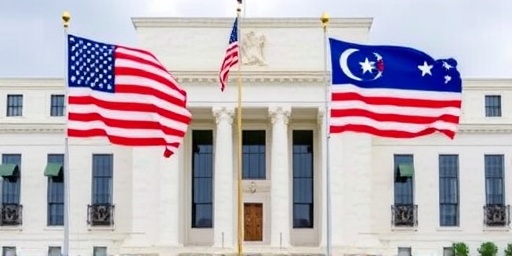In a stark reminder of economic headwinds, Federal Reserve Governor Lael Brainard Cook delivered a sobering assessment on Wednesday, stating that Inflation is stubbornly holding above the central bank’s 2% target at 2.8%, largely fueled by the lingering effects of tariffs imposed on key imports. Speaking at an economic forum in Washington, D.C., Cook emphasized that while these pressures are expected to ease over time, the path to price stability remains gradual and uncertain, influencing the Federal Reserve’s cautious approach to monetary policy.
- Governor Cook Details Tariff Impacts on Inflation Trajectory
- PCE Index Trends Reveal Stubborn Inflation Above 2% Target
- Federal Reserve’s Monetary Policy Stance in the Face of Tariff Headwinds
- Expert Perspectives on Balancing Tariffs and Inflation Control
- Looking Ahead: Economic Ramifications and Policy Pathways
Cook’s remarks come at a pivotal moment for the U.S. economy, as recent data from the Personal Consumption Expenditures (PCE) index—the Fed’s preferred gauge for Inflation—reveals ongoing challenges. The PCE index rose 2.8% year-over-year in the latest reading, exceeding the target and prompting questions about the timing of potential interest rate adjustments. Tariffs, particularly those on steel, aluminum, and consumer goods from major trading partners like China and the European Union, have been cited as a primary driver, adding to production costs and ultimately passing higher prices onto consumers.
Governor Cook Details Tariff Impacts on Inflation Trajectory
Federal Reserve Governor Cook did not mince words when addressing the role of tariffs in sustaining elevated inflation levels. ‘The imposition of tariffs has introduced persistent upward pressure on prices, particularly in sectors reliant on imported materials,’ Cook said during her keynote address. She pointed to data showing that tariff-related costs have contributed approximately 0.4 percentage points to the overall inflation rate since their implementation in 2018, with effects rippling through supply chains even as some trade tensions have eased.
To illustrate, Cook referenced the automotive industry, where tariffs on imported steel have increased vehicle manufacturing costs by up to 10%, according to a recent Fed study. This has led to a 3.5% rise in new car prices over the past year, directly impacting the PCE index’s goods component. ‘While tariffs were intended to protect domestic industries, their inflationary side effects have been more pronounced and longer-lasting than anticipated,’ she added, urging policymakers to consider these dynamics in future trade negotiations.
The governor’s comments align with broader Federal Reserve analyses, which have repeatedly highlighted how protectionist measures disrupt global supply chains. For instance, the U.S. International Trade Commission reported that tariffs on Chinese goods alone cost American households an average of $800 annually in higher prices. This economic drag has complicated the Fed’s monetary policy efforts, as officials balance inflation control with supporting growth amid a labor market that remains resilient but shows signs of cooling.
PCE Index Trends Reveal Stubborn Inflation Above 2% Target
The core of Cook’s message revolved around the PCE index, which strips out volatile food and energy prices to provide a clearer picture of underlying inflation trends. At 2.8%, the headline PCE rate marks a slight uptick from the previous month’s 2.7%, signaling that price pressures are not abating as quickly as hoped. The Fed’s longstanding 2% target, established in 2012, serves as a benchmark for sustainable economic health, and current readings indicate the economy is still grappling with post-pandemic recovery challenges compounded by external shocks like tariffs.
Delving deeper into the data, the PCE index’s services component climbed 3.1% year-over-year, driven by wage growth in a tight labor market, while goods inflation eased marginally to 1.9%. However, tariff-impacted categories such as electronics and apparel continue to buck the trend, with price increases exceeding 4%. Economists at the Federal Reserve Bank of New York have modeled that without tariff relief, the PCE could hover around 2.5% through 2024, delaying the return to the 2% target by at least six months.
Historical context underscores the significance of these figures. During the pre-tariff era, PCE inflation averaged 1.9% from 2010 to 2017, providing a stable backdrop for monetary policy. The deviation since then has forced the Federal Reserve to maintain elevated interest rates, with the federal funds rate at 5.25-5.50% since mid-2023. Cook noted that ‘achieving the 2% target requires not just domestic policy finesse but also resolution of international trade frictions.’
- PCE Index Breakdown: Headline: 2.8%; Core: 2.6%; Goods: 1.9%; Services: 3.1%
- Tariff Contribution Estimate: 0.4-0.6 percentage points to overall inflation
- Fed Target Timeline: Gradual decline expected by late 2025, per baseline projections
Federal Reserve’s Monetary Policy Stance in the Face of Tariff Headwinds
As inflation lingers above target, the Federal Reserve’s monetary policy remains in a holding pattern, with officials signaling no immediate rate cuts despite market expectations. Cook reiterated that the central bank is data-dependent, closely monitoring PCE readings and tariff developments before adjusting course. ‘Premature easing could reignite inflation, while overtightening risks recession,’ she warned, echoing Chair Jerome Powell’s recent testimonies before Congress.
The Fed’s toolkit, including quantitative tightening and forward guidance, is being deployed judiciously. Since peaking at 9.1% in June 2022, inflation has fallen significantly, but the plateau around 2.8% PCE has raised concerns about ‘sticky’ components resistant to standard monetary measures. Tariffs exacerbate this by acting as a supply-side shock, outside the Fed’s direct control, prompting calls for coordinated fiscal and trade policies.
Market reactions to Cook’s speech were muted, with the 10-year Treasury yield dipping slightly to 4.2% and stock indices showing modest gains. Analysts from Goldman Sachs noted that the Fed’s hawkish tilt on tariffs could delay rate cuts until Q3 2024, impacting borrowing costs for consumers and businesses. In a related development, the European Central Bank has voiced similar concerns, with ECB President Christine Lagarde stating that transatlantic tariffs could push global inflation higher by 0.2%.
To provide more granularity, here’s a timeline of key monetary policy actions influenced by inflation and tariffs:
- 2018: Initial tariffs implemented; PCE begins upward trend from 1.9%.
- 2020-2021: Pandemic boosts inflation to 4.2%; Fed maintains zero rates.
- 2022: Aggressive rate hikes begin as PCE hits 7%; tariffs add to pressures.
- 2023: Rates peak at 5.5%; PCE stabilizes but above target.
- 2024 Outlook: Potential pause in hikes if tariffs ease.
Expert Perspectives on Balancing Tariffs and Inflation Control
Economic experts have weighed in on Cook’s assessment, offering a mix of caution and optimism regarding the interplay between tariffs, inflation, and monetary policy. Dr. Elena Ramirez, chief economist at the Peterson Institute for International Economics, praised the Fed’s vigilance but criticized tariffs as ‘self-inflicted wounds’ that undermine inflation-fighting efforts. ‘The PCE index doesn’t lie—tariffs are inflating costs without delivering promised job gains,’ Ramirez told reporters post-speech.
Conversely, supporters of protectionist measures, including some labor unions, argue that tariffs safeguard American manufacturing. Mark Harlan, president of the United Steelworkers, countered that ‘without tariffs, we’d see even more offshoring, potentially worsening long-term inflation through supply vulnerabilities.’ This divide highlights the political dimension of the Federal Reserve’s challenges, as upcoming elections could reshape trade policies and, by extension, inflation trajectories.
Broader implications extend to consumer sentiment, with the University of Michigan’s latest survey showing inflation expectations at 3.1%—a slight rise attributed to tariff news. Businesses, meanwhile, are hedging against uncertainty; a National Association of Manufacturers poll found 62% of executives citing tariffs as a top concern for pricing strategies. The Federal Reserve’s upcoming dot plot, due in March, will be scrutinized for clues on how monetary policy might adapt to these pressures.
In academic circles, a recent paper from Harvard economists suggests that targeted tariff exemptions could shave 0.3% off PCE inflation without compromising trade goals. Cook alluded to such nuances, stating, ‘Monetary policy alone can’t solve supply-side issues; we need multifaceted approaches.’
Looking Ahead: Economic Ramifications and Policy Pathways
As the Federal Reserve navigates these turbulent waters, the forward-looking implications of sustained tariff effects on inflation are profound. Should PCE remain above 2.8%, the central bank may extend its higher-for-longer rate stance, potentially slowing GDP growth to 1.8% in 2024 from 2.5% last year, per IMF forecasts. Consumers could face continued sticker shock, with household spending power eroded by an estimated $1,200 annually due to tariff-driven price hikes.
On the horizon, negotiations to roll back certain tariffs—particularly those under review by the U.S. Trade Representative—could accelerate the return to the 2% target. Cook expressed measured hope, noting that ‘once tariff distortions fade, monetary policy transmission will improve, allowing for a soft landing.’ Market watchers anticipate the next FOMC meeting in May to incorporate fresh PCE data, possibly signaling the first rate cut if inflation shows signs of deceleration.
Globally, the U.S. stance influences allies; Canada’s Bank of Canada has already adjusted its monetary policy outlook citing American tariffs. Domestically, small businesses, hit hardest by import costs, are lobbying for relief, with the National Federation of Independent Business reporting a 15% cost increase in affected sectors. Ultimately, the Federal Reserve’s success in taming inflation will hinge on a delicate balance of domestic resilience and international cooperation, setting the stage for a more stable economic future.









